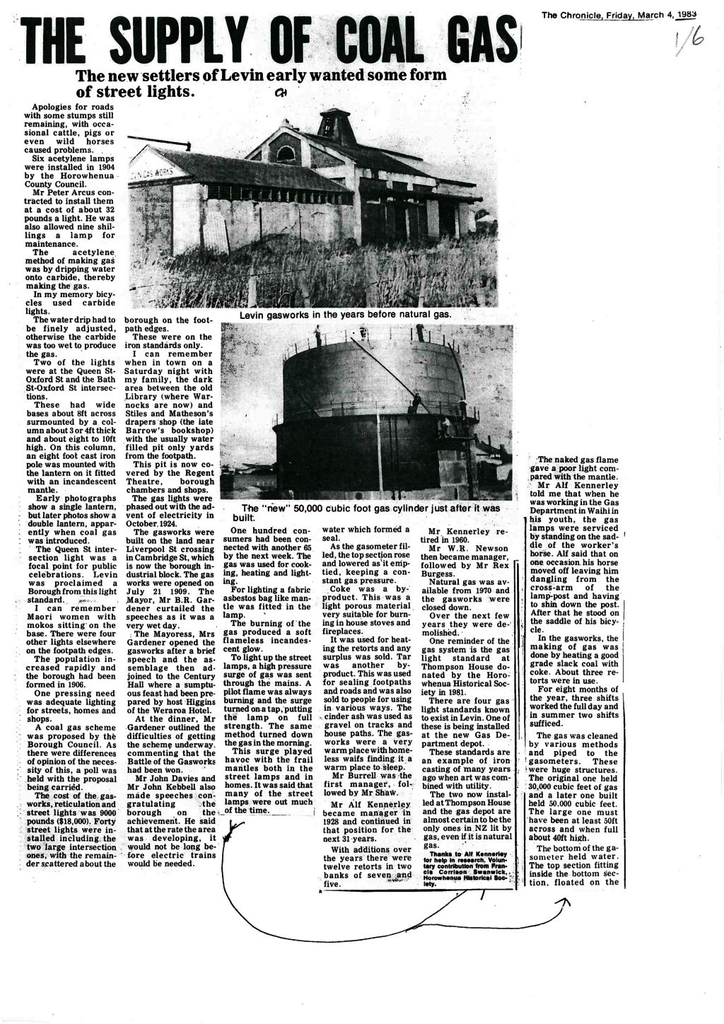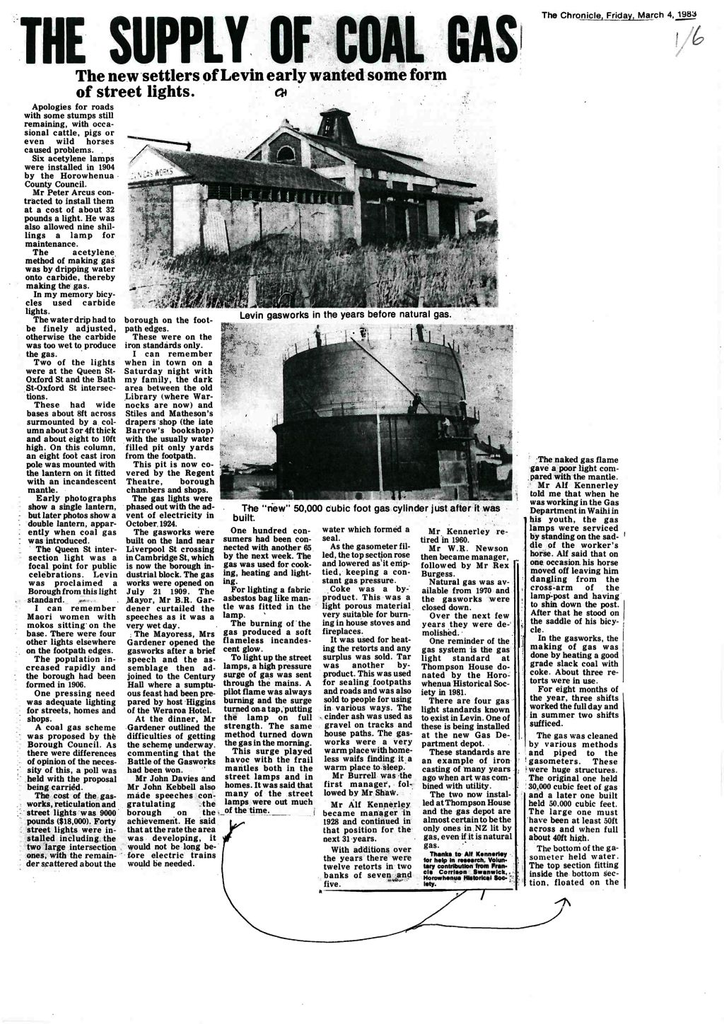Supply of Coal Gas for Levin
- Description
The new settlers of Levin early wanted some form of street lights. This text that follows is the content of the attached PDF.
The new settlers of Levin early wanted some form of street lights. Apologies for roads with some stumps still remaining, with occasional cattle, pigs or even wild horses caused problems.
Six acetylene lamps were installed in 1904 by the Horowhenua County Council. Mr Peter Arcus contracted to install them at a cost of about 32 pounds a light. He was allowed nine shillings a lamp for maintenance.
The acetylene method of making gas was by dripping water onto carbide, thereby making the gas. In my memory bicycles used carbide lights. The water drip had to be finely adjusted, otherwise the carbide was too wet to produce gas.
Two of the lights were at the Queen St-Oxford St and the Bath St-Oxford St intersections.These had wide bases about 8ft across surmounted by a column about 3 or 4 ft thick and about eight to 10ft high. On this column, an eight foot cast iron pole was mounted with the lantern on it fitted with an incandescent mantle. Early photographs show a single lantern, but later photos show a double lantern, apparently when coal gas was introduced.
The Queen St intersection light was a focal point for public celebrations. Levin was proclaimed a borough from this light standard. I can remember Maori women with mokos sitting on the base. There were four other lights elsewhere on the footpath edges.
The population increased rapidly and the borough had been formed in 1906. One pressing need was for adequate lighting for streets, homes and shops.
A coal gas scheme was proposed by the Borough Council. As there were differences of opinion of the necessity of this, a poll was held with the proposal being carried.
The cost of the gasworks, reticulation and street lights was 9000 pounds ($18,000). Forty street lights were installed including the two large intersection ones, with the remainder scattered about the borough on the footpath edges. These were on the iron standards only.
I can remember when in town on a Saturday night with my family, the dark area between the old library (where Warnocks are now) and Stiles and Matheson's drapers shop (the late Barrow's bookshop) with the usually water filled pit only yards from the footpath. This pit is now covered by the Regent Theatre, borough chambers and shops.
The gas lights were phased out with the advent of electricity in October 1924.
 The gasworks were built on the land near Liverpool St crossing in Cambridge St which is now the Borough industrial block. The gasworks were opened on July 21 1909. The Mayor, Mr B.R. Gardener curtailed the speeches because it was a very wet day. The Mayoress, Mrs Gardener opened the gasworks after a brief speech and the assemblage then adjourned to the Century Hall, where a sumptuous feast had been prepared by host Higgins of the Weraroa Hotel. At the dinner, Mr Gardener outlined the difficulties of getting the scheme underway, commenting that the Battle of the Gasworks had been won.
The gasworks were built on the land near Liverpool St crossing in Cambridge St which is now the Borough industrial block. The gasworks were opened on July 21 1909. The Mayor, Mr B.R. Gardener curtailed the speeches because it was a very wet day. The Mayoress, Mrs Gardener opened the gasworks after a brief speech and the assemblage then adjourned to the Century Hall, where a sumptuous feast had been prepared by host Higgins of the Weraroa Hotel. At the dinner, Mr Gardener outlined the difficulties of getting the scheme underway, commenting that the Battle of the Gasworks had been won.Mr John Davies and Mr John Kebbell also made speeches congratulating the borough on the achievement. He said that at the rate the area was developing, it would not be long before electric trains would be needed.
One hundred consumers had been connected with another 65 by the next week. The gas was used for cooking, heating and lighting. For lighting, a fabric asbestos bag-like mantle was fitted in the lamp. The burning of the gas produced a soft flameless incandescent glow.
To light up the street lamps, a high pressure surge of gas was sent through the mains. A pilot flame was always burning and the surge turned on a tap, putting the lamp on full strength. The same method turned down the gas in the morning.
This surge played havoc with the fragile mantles both in the street lamps and in the homes. It was said that many of the street lamps were out much of the time. The naked gas flame gave a poor light compared with the mantle.
Mr Alf Kennerley told me that when he was working in the Gas Department in Waihi in his youth, the gas lamps were serviced by standing on the saddle of the worker's horse. Alf said that on one occasion his horse moved off leaving him dangling from the cross-arm of the lamp-post and having to shin down the post. After that he stood on the saddle of his bicycle.
In the gasworks, the making of gas was done by heating a good grade of slack coal with coke. About three retorts were in use.For eight months of the year, three shifts worked the full day, and in the summer two shifts sufficed.
 The gas was cleaned by various methods and piped to the gasometers. These were huge structures. The original one held 30,000 cubic feet of gas and a later one built held 50,000 cubic feet. The large one must have been at least 50ft across and when full about 40ft high.
The gas was cleaned by various methods and piped to the gasometers. These were huge structures. The original one held 30,000 cubic feet of gas and a later one built held 50,000 cubic feet. The large one must have been at least 50ft across and when full about 40ft high. The bottom of the gasometer held water. The top section fitting inside the bottom section, floated on the water which formed a seal. As the gasometer filled, the top section rose and lowered as it emptied, keeping a constant gas pressure.
Coke was a by-product. This was a light porous material, very suitable for burning in house stoves and fireplaces.
It was used for heating the retorts and any surplus was sold. Tar was another by-product. This was used for sealing footpaths and roads and was also sold to people for using in various ways. The cinder ash was used as gravel on tracks and house paths. The gasworks were a very warm place, with homeless waifs finding it a warm place to sleep.
Mr Burrell was the first manager, followed by Mr Shaw. Mr Alf Kennerley became manager in 1928 and continued in that position for the next 31 years. With additions over the years there were twelve retorts in two banks of seven and five. Mr Kennerley retired in 1960. Mr W.R. Newson then became manager, followed by Mr Rex Burgess.
Natural gas was available from 1970 and the gasworks were closed down. Over the next few years they were demolished.
One reminder of the gas system is the light standard at Thompson House donated by the Horowhenua Historical Society in 1981. There are four gas light standards known to exist in Levin. One of these is being installed at the new Gas Department depot. These standards are an example of iron casting of many years ago, when art was combined with utility. The two now installed at Thompson House and the gas depot are almost certain to be the only ones in NZ lit by gas, even if natural gas.
Thanks to Alf Kennerley for help in research.
Identification
- Date
- March 4, 1983
Taxonomy
- Community Tags


